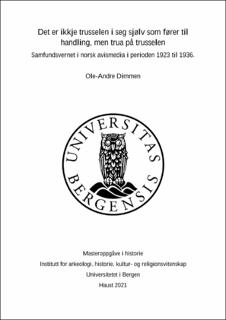| dc.description.abstract | When the Norwegian Labour Party, at that time the largest party in Norway, in 1919 chose to follow the revolutionary line by joining the Communist International (Comintern), many within the bourgeoisie feared the country was at risk of revolution just as in Russia and Finland just a few years earlier. As a consequence, right-wing militias were formed also in Norway, mainly inspired by the Finnish Protection Corps (Skyddskår). In 1923, several of the Norwegian militias joined together in one large group, called Samfundsvernet (‘Protection of Society’). In the coming years, the legitimacy of this group became one of the most debated issues in the Norwegian public. This thesis analyses how Samfundsvernet was presented in newspaper media and discussed in the Norwegian public during the interwar years. Applying the method of frame-analysis, the thesis explores how the group was legitimized by its political allies and delegitimized by its enemies, and how this debate was related to more general issues of political culture, especially the understanding of the state monopoly of power. As most newspapers at the time had a party-political affiliation, the study analyses the main newspapers representing the range of political parties in Norway; Aftenposten (Høyre), Arbeiderbladet (Arbeiderpartiet), Dagbladet (Venstre) and Nationen (Bondepartiet). In addition to these newspapers, a couple of minor local newspapers as well as parliamentary debates have been used in the analysis. In this thesis I have found three major frames in the debate about Samfundsvernet; One supporting frame from the right-wing, arguing that the group played a major role in preventing a communist revolutionary attempt; one critical frame from the left-wing arguing that Samfundsvernet was fascist and revolutionary themselves; and one “middle position” from the liberals (Dagbladet/Venstre) arguing Samfundsvernet was a threat to the democratic system and the state monopoly of power. This middle position was, unlike the other two, not based on the principle of social class, but instead the democratic and parliamentary principles. As a result of its “neutral” position, this frame grew stronger and contributed to the dissolution of all militias (right and left) and lead to an enforcement of the state monopoly of power represented by the police. This consensus might have contributed to a democratization of political discourse in Norway. | |
